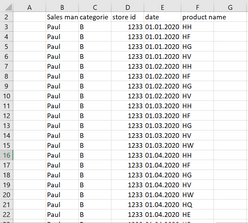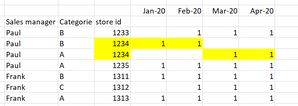- Power BI forums
- Updates
- News & Announcements
- Get Help with Power BI
- Desktop
- Service
- Report Server
- Power Query
- Mobile Apps
- Developer
- DAX Commands and Tips
- Custom Visuals Development Discussion
- Health and Life Sciences
- Power BI Spanish forums
- Translated Spanish Desktop
- Power Platform Integration - Better Together!
- Power Platform Integrations (Read-only)
- Power Platform and Dynamics 365 Integrations (Read-only)
- Training and Consulting
- Instructor Led Training
- Dashboard in a Day for Women, by Women
- Galleries
- Community Connections & How-To Videos
- COVID-19 Data Stories Gallery
- Themes Gallery
- Data Stories Gallery
- R Script Showcase
- Webinars and Video Gallery
- Quick Measures Gallery
- 2021 MSBizAppsSummit Gallery
- 2020 MSBizAppsSummit Gallery
- 2019 MSBizAppsSummit Gallery
- Events
- Ideas
- Custom Visuals Ideas
- Issues
- Issues
- Events
- Upcoming Events
- Community Blog
- Power BI Community Blog
- Custom Visuals Community Blog
- Community Support
- Community Accounts & Registration
- Using the Community
- Community Feedback
Register now to learn Fabric in free live sessions led by the best Microsoft experts. From Apr 16 to May 9, in English and Spanish.
- Power BI forums
- Forums
- Get Help with Power BI
- Desktop
- Cumulative Distinct Count with variables
- Subscribe to RSS Feed
- Mark Topic as New
- Mark Topic as Read
- Float this Topic for Current User
- Bookmark
- Subscribe
- Printer Friendly Page
- Mark as New
- Bookmark
- Subscribe
- Mute
- Subscribe to RSS Feed
- Permalink
- Report Inappropriate Content
Cumulative Distinct Count with variables
Hi Everyone,
Background:
- I have a dataset recording visits of sales managers in stores
- Each visit create multiple entry lines as the sales managers try to sell multiple products to the store
- Each store has a performance categorie (from A - best - to C - worse) and its categorie can change thoughout the time
- A store can be visited once a month at most but not all stores are visited in a month
- A store is visited by one single sales manager
See screenshot below of the sample dataset i have (only for one store and one sales manager)
What I want to achieve:
I d like to show the development (per month) of the performance of the stores per sales managers per store categorie on a deep dive level (per store) and aggregated level. Therefore I d like to do the cumulative distinct count of stores, taking into account the store categorie, sales managers and month
See screenshots below of the tables I d like to get:
What I have:
I have created a measure that calculated the cumulative distinct count of stores and get filters per store catgeorie, sales manager & month (see DAX code below). However as soon as a store change categorie, it continues counting the store for the old categorie and start counting for the new categorie
# cumulative stores = VAR results = CALCULATE( DISTINCTCOUNT('Reports'[store id]), FILTER(ALLSELECTED(Date),date[Date]<= MAX(date[Date]))) RETURN results
See screenshot below of the table i get using the above measure:
Please let me know if you have a solution :),
Best,
Kevin
Solved! Go to Solution.
- Mark as New
- Bookmark
- Subscribe
- Mute
- Subscribe to RSS Feed
- Permalink
- Report Inappropriate Content
@Kevin_Conseil
If you can create a short sample and put it into pbix, it would be clear for me. For now, you can try add additional filters in the measure, because you are looking to count and filter by the salesman and categories.
result = CALCULATE( DISTINCTCOUNT('Reports'[store id]), FILTER(ALLSELECTED(Date),[Salesman]=max([Salesman]) && [categories]=max([categories]) && date[Date]<= MAX(date[Date])))
Paul Zheng _ Community Support Team
If this post helps, then please consider Accept it as the solution to help the other members find it more quickly.
- Mark as New
- Bookmark
- Subscribe
- Mute
- Subscribe to RSS Feed
- Permalink
- Report Inappropriate Content
@Kevin_Conseil
If you can create a short sample and put it into pbix, it would be clear for me. For now, you can try add additional filters in the measure, because you are looking to count and filter by the salesman and categories.
result = CALCULATE( DISTINCTCOUNT('Reports'[store id]), FILTER(ALLSELECTED(Date),[Salesman]=max([Salesman]) && [categories]=max([categories]) && date[Date]<= MAX(date[Date])))
Paul Zheng _ Community Support Team
If this post helps, then please consider Accept it as the solution to help the other members find it more quickly.
Helpful resources

Microsoft Fabric Learn Together
Covering the world! 9:00-10:30 AM Sydney, 4:00-5:30 PM CET (Paris/Berlin), 7:00-8:30 PM Mexico City

Power BI Monthly Update - April 2024
Check out the April 2024 Power BI update to learn about new features.

| User | Count |
|---|---|
| 114 | |
| 97 | |
| 86 | |
| 70 | |
| 62 |
| User | Count |
|---|---|
| 151 | |
| 120 | |
| 103 | |
| 87 | |
| 68 |




